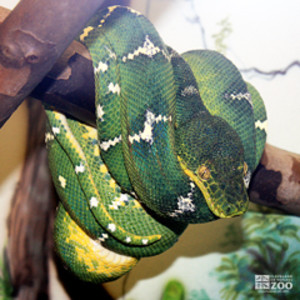Emerald Tree Boa
[Corallus caninus]

The Emerald Tree Boa is a brilliant green in color on top, patterned with white or yellow triangular blotches. The under side is yellow. Neonates are terra cotta, or occasionally bluish-green in color, patterned with white. As they grow, green flecks appear over the body increasing in size and number until the emerald green of the adult appears. Adults boas can reach up to 6 feet in length. Huge, fang-like teeth assure rapid penetration and a secure grip through the feathers and/or fur of their prey. These snakes are non-venomous.
Location: The Lower RainForest
Share:
Range
The emerald tree boas range is the Amazon Basin: Peru, Ecuador, Brazil and Bolivia to the Guianas.
Habitat
Emerald tree boas inhabit trees and bushes adjacent to water courses, swamps and marshes in rain forests.
Conservation Status
Least ConcernPrimary Threats
Illegal Wildlife TradeGestation
Unknown. Eggs are hatched within the female, and the young are born live.
Litter
From 6-14Behavior
Arboreal and nocturnal, emerald tree boas spend the day draped in symmetrical coils over branches, the prehensile tail assuring a firm grip. Prey is constricted and often ingested while the boa is suspended from a branch, which is gripped by the tail and posterior body. All species of Corallus have well developed labial thermoreceptors. Sensitive to minute temperature gradients, these thermoreceptors aid the snake in locating its prey and aiming its strike. This boa is said to be mean-tempered in captivity.
Reproduction
Emerald Tree Boas give birth to living young, the size of the litter and neonates varying with the size of the female. Newly born young are distinctive brick-red to orange in color that goe through a color change, ontogenetic, at 12 months and turn green.
